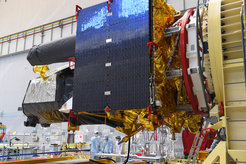eROSITA arrives at Baikonur
On 25 April 2019, the Spektr-RG Space Observatory was transported to the Baikonur Cosmodrome - the final stage in preparation for its launch on 21 June. Spektr-RG carries the X-ray telescope eROSITA, which was developed and built at MPE. Its aim is to perform a highly sensitive survey of the entire sky in X-ray light, once it arrives at its observation point L2.

In Baikonur, the Spektr-RG space observatory will be subject to final ground tests and will be integrated into the launch vehicle. The launch is planned for 21 June 2019 with a Proton M launcher and a DM-03 upper stage. Members of the eROSITA team will carry out final tests and preparations for launch at the beginning of May.
The eROSITA X-ray space telescope consists of seven identical mirror modules with 54 nested gold-coated mirrors each, manufactured very precisely to collect the high-energy photons and guide them to the X-ray sensitive cameras placed at their focus. These cameras have also been developed and custom-built at MPE, containing special X-ray CCDs manufactured from high-purity silicon, which were supplied by the MPG Halbleiterlabor. For maximum performance, these cameras have to be cooled to -90°C using a complex heat pipe system.

In addition to eROSITA, Spektr-RG also carries the Russian telescope “ART-XC”. Both instruments will fly from the Russian launch site Baikonur in Kazakhstan with a rocket to the second Lagrange point (L2) of the Sun-Earth system
Leaving Earth behind, eROSITA will then travel to the second Lagrange point (L2) of the Sun-Earth system, at a distance of about 1.5 million kilometres. Over a period of four years, eROSITA will carry out a total of eight scans of the entire sky to measure about 100,000 galaxy clusters, find about three million supermassive black holes and make many other interesting discoveries. This new sky survey, with much improved energy resolution and 20 times higher sensitivity than the previous one performed by ROSAT, will give scientists a closer insight into the origin and evolution of the universe.













